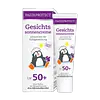What's inside
What's inside
 Key Ingredients
Key Ingredients

 Benefits
Benefits

 Concerns
Concerns

 Ingredients Side-by-side
Ingredients Side-by-side

Butyl Methoxydibenzoylmethane 3%
UV AbsorberHomosalate 10%
Skin ConditioningEthylhexyl Salicylate 5%
UV AbsorberOctocrylene 5%
UV AbsorberWater
Skin ConditioningAlcohol Denat.
AntimicrobialLauryl Methacrylate/Sodium Methacrylate Crosspolymer
Diethylhexyl 2,6-Naphthalate
EmollientGlycerin
HumectantDextrin Palmitate
EmulsifyingDicaprylyl Ether
EmollientPhenoxyethanol
PreservativeAcrylates/C10-30 Alkyl Acrylate Crosspolymer
Emulsion StabilisingGlyceryl Behenate
EmollientPhenyl Trimethicone
Skin ConditioningParfum
MaskingCetyl Alcohol
EmollientSorbitan Distearate
EmollientLimonene
PerfumingSodium Hydroxide
BufferingStearoyl Glutamic Acid
CleansingArginine
MaskingLinalool
PerfumingGeraniol
PerfumingDisodium EDTA
Citral
PerfumingSodium Hyaluronate
HumectantButyl Methoxydibenzoylmethane 3%, Homosalate 10%, Ethylhexyl Salicylate 5%, Octocrylene 5%, Water, Alcohol Denat., Lauryl Methacrylate/Sodium Methacrylate Crosspolymer, Diethylhexyl 2,6-Naphthalate, Glycerin, Dextrin Palmitate, Dicaprylyl Ether, Phenoxyethanol, Acrylates/C10-30 Alkyl Acrylate Crosspolymer, Glyceryl Behenate, Phenyl Trimethicone, Parfum, Cetyl Alcohol, Sorbitan Distearate, Limonene, Sodium Hydroxide, Stearoyl Glutamic Acid, Arginine, Linalool, Geraniol, Disodium EDTA, Citral, Sodium Hyaluronate
Water
Skin ConditioningC12-15 Alkyl Benzoate
AntimicrobialDibutyl Adipate
EmollientDiethylamino Hydroxybenzoyl Hexyl Benzoate
UV FilterDiisopropyl Sebacate
EmollientGlycerin
HumectantDiethylhexyl Butamido Triazone
UV AbsorberPolyglyceryl-6 Stearate
EmollientBis-Ethylhexyloxyphenol Methoxyphenyl Triazine
Skin ConditioningEthylhexyl Triazone
UV AbsorberPhenylbenzimidazole Sulfonic Acid
UV AbsorberCellulose
AbsorbentMicrocrystalline Cellulose
AbsorbentCellulose Gum
Emulsion StabilisingHydroxyacetophenone
AntioxidantPolyglyceryl-6 Behenate
Emulsion StabilisingSodium Hydroxide
BufferingXanthan Gum
Emulsifying1,2-Hexanediol
Skin ConditioningCaprylyl Glycol
EmollientCetearyl Alcohol
EmollientGlyceryl Stearate
EmollientSilica
AbrasivePullulan
Sclerotium Gum
Emulsion StabilisingCarnosine
Skin ConditioningMalus Domestica Fruit Extract
AntioxidantLysolecithin
EmulsifyingSodium Phytate
Tocopherol
AntioxidantHelianthus Annuus Seed Oil
EmollientWater, C12-15 Alkyl Benzoate, Dibutyl Adipate, Diethylamino Hydroxybenzoyl Hexyl Benzoate, Diisopropyl Sebacate, Glycerin, Diethylhexyl Butamido Triazone, Polyglyceryl-6 Stearate, Bis-Ethylhexyloxyphenol Methoxyphenyl Triazine, Ethylhexyl Triazone, Phenylbenzimidazole Sulfonic Acid, Cellulose, Microcrystalline Cellulose, Cellulose Gum, Hydroxyacetophenone, Polyglyceryl-6 Behenate, Sodium Hydroxide, Xanthan Gum, 1,2-Hexanediol, Caprylyl Glycol, Cetearyl Alcohol, Glyceryl Stearate, Silica, Pullulan, Sclerotium Gum, Carnosine, Malus Domestica Fruit Extract, Lysolecithin, Sodium Phytate, Tocopherol, Helianthus Annuus Seed Oil
 Reviews
Reviews

Ingredients Explained
These ingredients are found in both products.
Ingredients higher up in an ingredient list are typically present in a larger amount.
Glycerin is already naturally found in your skin. It helps moisturize and protect your skin.
A study from 2016 found glycerin to be more effective as a humectant than AHAs and hyaluronic acid.
As a humectant, it helps the skin stay hydrated by pulling moisture to your skin. The low molecular weight of glycerin allows it to pull moisture into the deeper layers of your skin.
Hydrated skin improves your skin barrier; Your skin barrier helps protect against irritants and bacteria.
Glycerin has also been found to have antimicrobial and antiviral properties. Due to these properties, glycerin is often used in wound and burn treatments.
In cosmetics, glycerin is usually derived from plants such as soybean or palm. However, it can also be sourced from animals, such as tallow or animal fat.
This ingredient is organic, colorless, odorless, and non-toxic.
Glycerin is the name for this ingredient in American English. British English uses Glycerol/Glycerine.
Learn more about GlycerinSodium Hydroxide is also known as lye or caustic soda. It is used to adjust the pH of products; many ingredients require a specific pH to be effective.
In small amounts, sodium hydroxide is considered safe to use. However, large amounts may cause chemical burns due to its high alkaline.
Your skin has a natural pH and acid mantle. This acid mantle helps prevent harmful bacteria from breaking through. The acid mantle also helps keep your skin hydrated.
"Alkaline" refers to a high pH level. A low pH level would be considered acidic.
Learn more about Sodium HydroxideWater. It's the most common cosmetic ingredient of all. You'll usually see it at the top of ingredient lists, meaning that it makes up the largest part of the product.
So why is it so popular? Water most often acts as a solvent - this means that it helps dissolve other ingredients into the formulation.
You'll also recognize water as that liquid we all need to stay alive. If you see this, drink a glass of water. Stay hydrated!
Learn more about Water